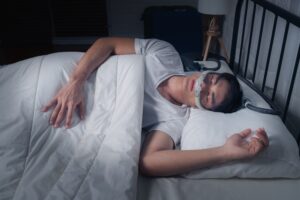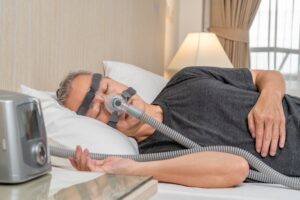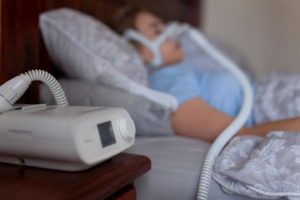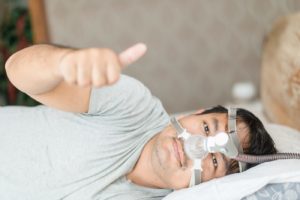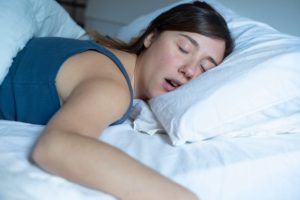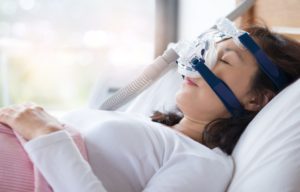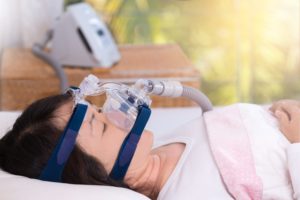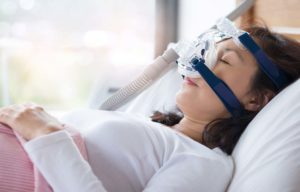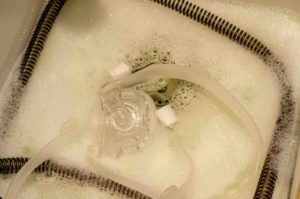When you buy through our links, we may earn a commission. Products or services may be offered by an affiliated entity. Learn more.
How to Use a CPAP Machine for Better Sleep
Millions of Americans have been diagnosed with obstructive sleep apnea (OSA) a serious disorder of interrupted breathing during sleep. For people with OSA, repeated pauses in breath occur when the airway at the back of the throat becomes blocked during sleep.
The first-line treatment for OSA in adults is with a continuous positive airway pressure (CPAP) device. CPAP machines work by pressurizing air that is delivered through a hose and mask into the airway during sleep. The steady flow of air keeps the airway open , improving respiration and sleep quality.
In order to get the benefits of a CPAP, it’s important to set it up properly. Knowing the right steps can ensure that it’s working correctly and help you get used to sleeping with a CPAP.
Suspect You May Have Sleep Apnea?
Answer three questions to understand if you should be concerned.
Step-by-Step Instructions for How to Setup and Use a CPAP Machine
If you’ve been given a prescription for a CPAP machine, it’s normal to have questions about how to set it up and use it in the right way. The process is straightforward and follows a series of steps.
Find a Good Space to Put the CPAP Machine
A first step is deciding where you’re going to put the CPAP. A good space for your device meets these characteristics:
- Provides stable support to the base of the CPAP
- Allows the hose to reach the head of the bed
- Close enough to an outlet so that you can easily plug in the machine
- Permits unobstructed ability to turn on the device, open the filter compartment, and add water to the humidifier
For most people, the optimal spot is on a nightstand or small table next to their bed.
Check the Filter
The CPAP machine comes with a replaceable filter, but the exact type of filter depends on your device. There is usually a small compartment in which the filter fits snugly. Written instructions or instructions from your sleep technician should provide specific details about the filter in your CPAP machine.
Attach the Hose to the CPAP Machine
The machine has a special connector for the hose. The hose should attach and stay in place without exerting considerable force or effort.
Attach the Hose to the Mask
The other end of the hose plugs into the CPAP mask and should create a tight connection, sometimes by clicking into place.
Set Up the Humidifier (When Applicable)
Many CPAP machines have an attached humidifier to moisturize the air so that it’s less likely to dry out your mouth and throat over the course of the night.
If your CPAP has a humidifier, fill it with distilled water only. Using distilled water prevents mineral buildup or any impurity issues that can come from using tap water.
The humidifier reservoir should have a clear “MAX” fill line. Be careful not to exceed that level, which can cause water to enter the hose.
Plug in the CPAP
Make sure that the power cord is properly attached to the CPAP device, and then plug the device into an electrical outlet.
Put On and Adjust the Mask
There are several types of masks that can be used with a CPAP. Full-face masks go over your nose and mouth. Other masks go over the nose or just underneath it. Your doctor or sleep specialist will recommend a mask based on several factors including how you breathe, the pressure you need, and your sleeping position.
Regardless of the type of mask you use, it will be held in place using one or more straps that go around the top and/or back of your head.
Start by positioning the mask on your face, and then attach or pull the straps to secure it. The mask should form a seal against your face, but it should not pinch or press deeply into your skin. Adjust the length of the straps to find a comfortable fit.
Turn On the Device
Once you have the mask in place, you can turn on your CPAP machine. The pressure settings will have already been set by your health care team, so you should be able to plug-and-play.
When the machine is on, you will notice pressurized air coming through the mask. If you hear air escaping from the mask, it’s a sign that you need to adjust it for a tighter seal. Some CPAP machines have a function to test whether the mask has a good seal.
When the device is turned on, you can decide whether to use the Ramp function. This starts with lower pressure that gradually increases before reaching your prescribed pressure for the night. Some people like to ease into their sleep with the Ramp function while others like to have full pressure from the start.
Find a Comfortable Sleeping Position
Test out a few sleeping positions to find those that are comfortable for your body, don’t interfere with your ability to wear the mask, and don’t pinch or block the hose.
Tips for Getting Used to a CPAP Machine
Even with the best cpap machine, most people find it difficult to get started. The mask may be uncomfortable, the sensation of the pressurized air can be unsettling, and on some machines, noise from the device can be bothersome.
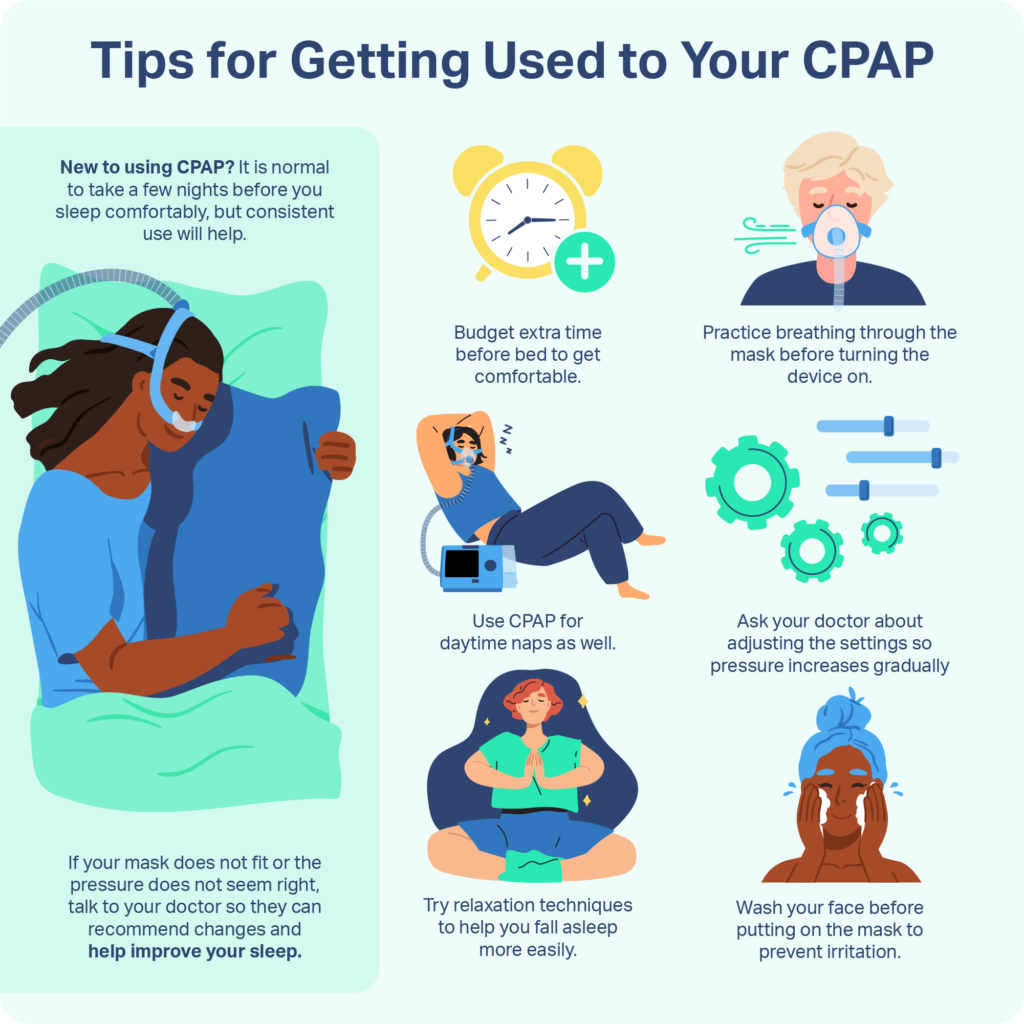
It’s normal for there to be an adjustment period before you are accustomed to and sleeping comfortably while using a CPAP. Several tips can help you get used to your CPAP.
- Expect it to take at least a few nights to adjust. Don’t give up or despair if you find the mask annoying or bothersome. You may even have a hard time sleeping at first, but you’ll get used to the CPAP faster by sticking with it. Over time, your sleep should improve.
- Budget extra time to get set up before bed. As you’re getting started with the CPAP device, it’s helpful to allot a bit of extra time before bed to fill the humidifier, get the mask on correctly, and position yourself comfortably.
- Practice wearing the mask and breathing with it on. To help get used to the mask, you can wear it without turning the machine on and practice breathing without any air coming through.
- Use the CPAP anytime you sleep. Most people think mostly about nighttime, but it’s best to wear the CPAP for any daytime naps as well.
- Consider using the Ramp function. If you’re having a hard time falling asleep because of the pressure, try using the Ramp function to have it kick in more gradually.
- Utilize relaxation exercises. Some people get anxious or claustrophobic when wearing a CPAP mask, and relaxation techniques can help put your mind at ease. Many of these steps for relaxation also help to fall asleep more easily.
- Wash your face before putting on the mask. Keeping your face clean can help create a good seal and reduce the potential for irritation during the night.
Another part of getting used to the CPAP is remembering to communicate with your doctor or sleep technician. If your mask isn’t comfortable, there is often another option to try that has a different size, shape, or type of cushioning. Similarly, if the pressure doesn’t seem right, your health care team can determine whether any adjustments are needed.
Other Tips for CPAP Users
When you first open your CPAP, write down the brand, model, and serial number. Keep that information with the owner’s manual. In the same place, jot down the phone number for your sleep technician, the CPAP manufacturer, and, if applicable, the local service provider who delivered your machine. These steps will simplify the process if you have any technical problems in the future.
In order to keep your CPAP working in top shape, you’ll want to keep your mask, hose, and humidifier clean. Establishing a routine for frequent cleaning allows you to avoid buildup of dirt, bacteria, or other contaminants.
Another tip is to think in advance about using your CPAP when traveling and to plan out the logistics of bringing the device with you.
What About BiPAP or APAP Devices?
The setup and use of bi-level positive airway pressure (BiPAP) or auto-titrating positive airway pressure (APAP) devices is virtually the same as with a CPAP. While these machines provide variable levels of pressure, their basic design is similar, and you can follow the same steps to use and get used to them.
Possible Complications From a CPAP Machine
While a CPAP device dramatically improves sleep in most people with sleep apnea, there can be uncomfortable side effects. . In most cases, these issues arise primarily in the first few nights, but some may persist over time. Common side effects include:
- Dry mouth
- Nosebleeds
- Nasal congestion
- Runny nose
- Respiratory infections
- Skin irritation from the mask or straps
- Chest discomfort
If you experience these issues, contact your doctor or sleep technician. Changes in settings or other steps can usually resolve these side effects of CPAP therapy and make it easier for you to sleep well while using the device.

Still have questions? Ask our community!
Join our Sleep Care Community — a trusted hub of product specialists, sleep health professionals, and people just like you. Whether you’re searching for the perfect mattress or need expert sleep advice, we’ve got you covered. Get personalized guidance from the experts who know sleep best.
References
2 Sources
-
Pinto, V. L., & Sharma, S. (2022, May 2). Continuous positive airway pressure (CPAP). In StatPearls. StatPearls Publishing., Retrieved September 22, 2022, from
https://www.ncbi.nlm.nih.gov/books/NBK482178/ -
A.D.A.M. Medical Encyclopedia. (2020, January 29). Positive airway pressure treatment. MedlinePlus., Retrieved September 22, 2022, from
https://medlineplus.gov/ency/article/001916.htm






